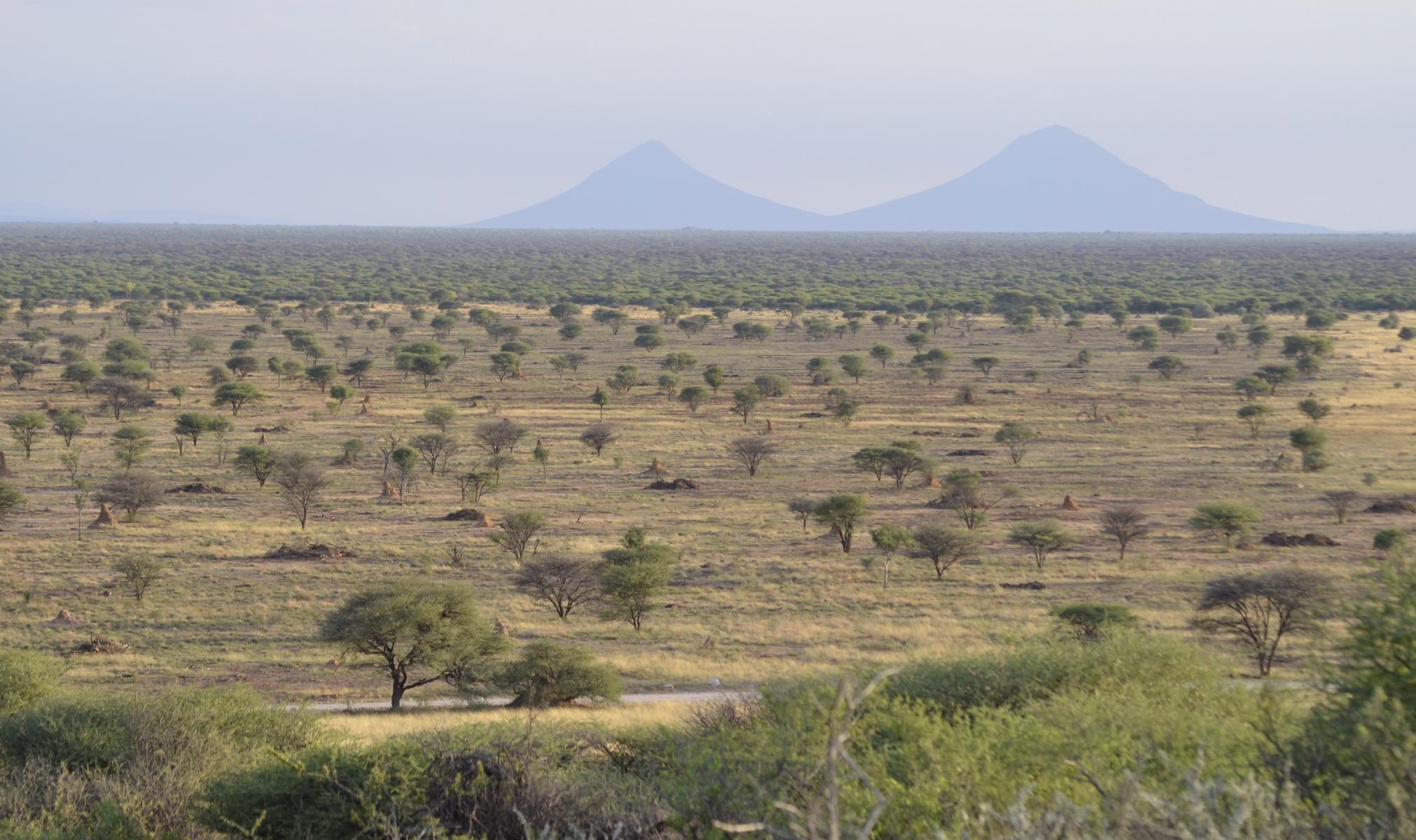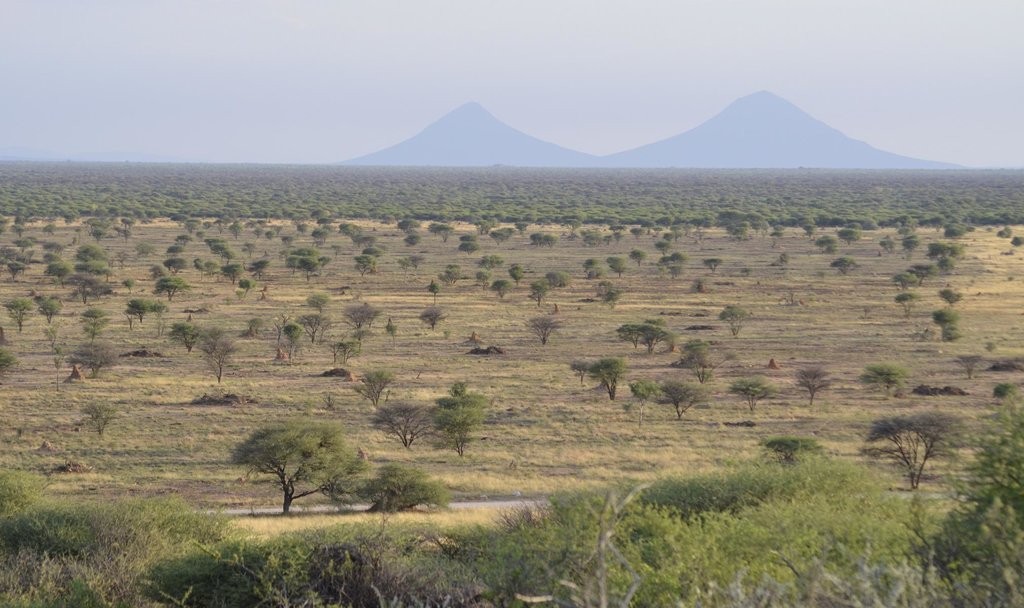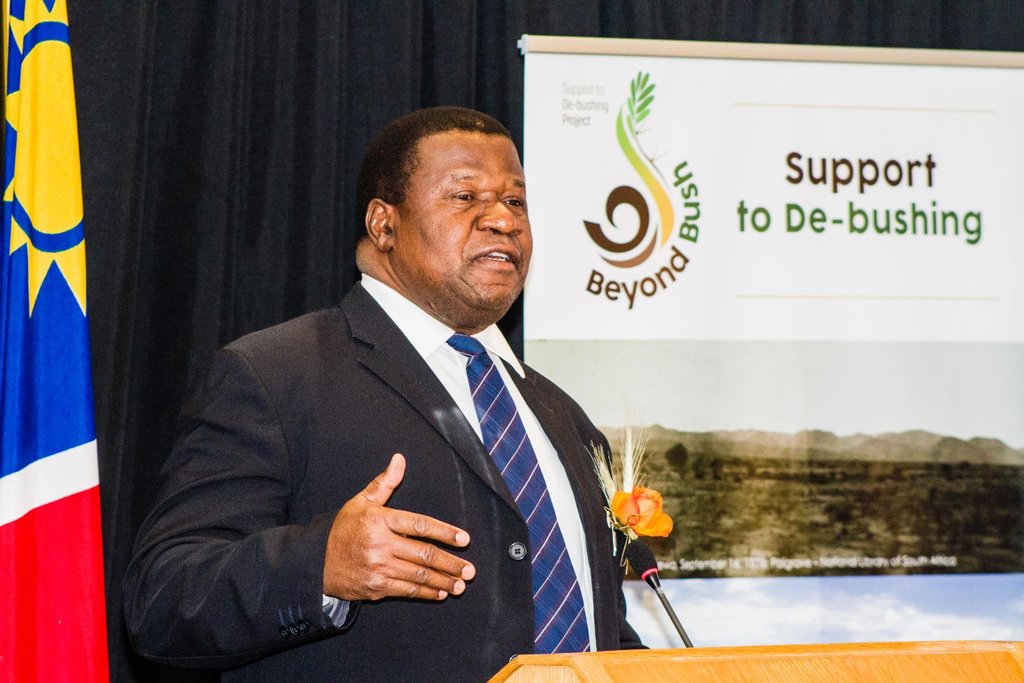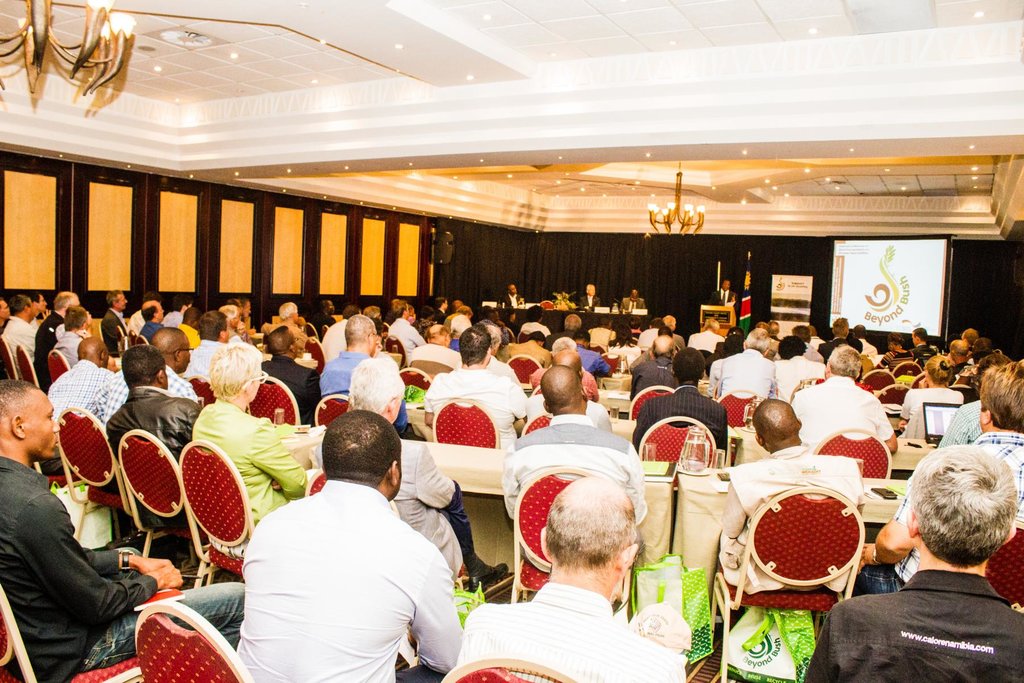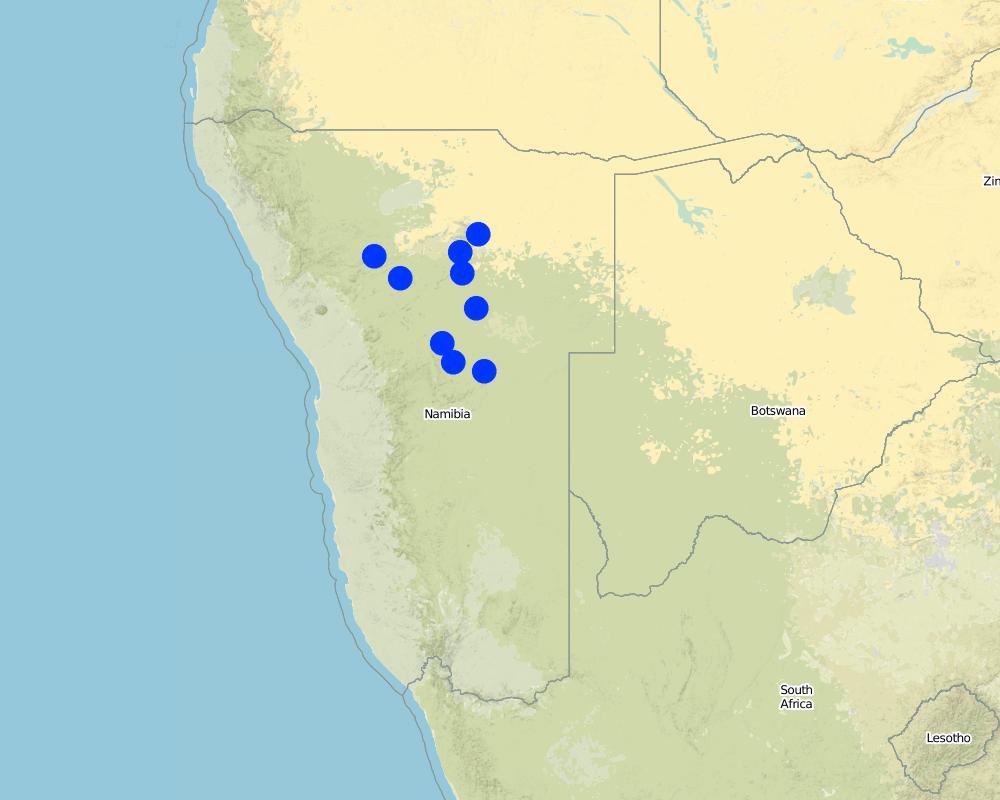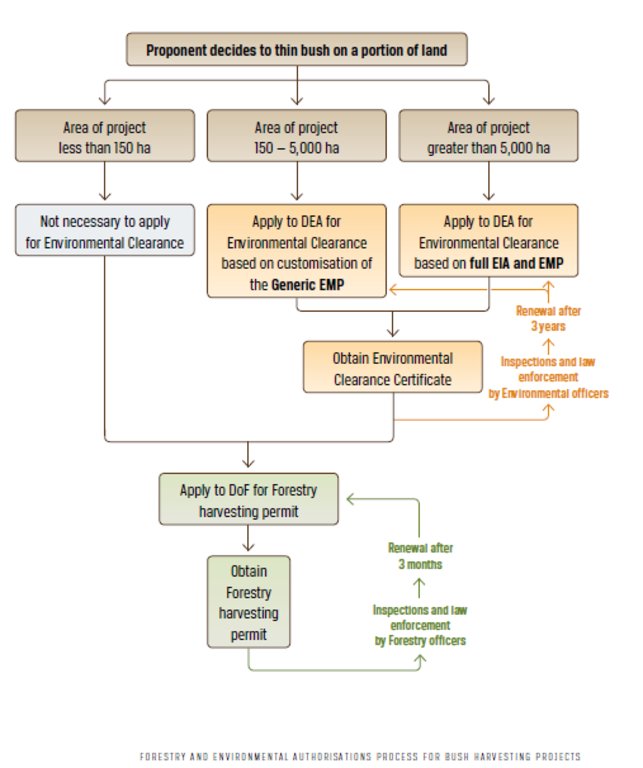Bush Control and Biomass Utilisation [纳米比亚]
- 创建:
- 更新:
- 编制者: Johannes Laufs
- 编辑者: –
- 审查者: Rima Mekdaschi Studer
Bush Control and Biomass Utilisation
approaches_2809 - 纳米比亚
查看章节
全部展开 全部收起1. 一般信息
1.2 参与方法评估和文件编制的资源人员和机构的联系方式
有助于对方法进行记录/评估的机构名称(如相关)
Deutsche Gesellschaft für Internationale Zusammenarbeit (GIZ) GmbH (GIZ) - 德国1.3 关于使用通过WOCAT记录的数据的条件
(现场)数据是什么时候汇编的?:
01/06/2015
编制者和关键资源人员接受有关使用通过WOCAT记录数据的条件。:
是
1.4 SLM技术问卷的参考
2. SLM方法的描述
2.1 该方法的简要说明
Public and private stakeholders in Namibia cooperate in the implementation of a national Bush Control and Biomass Utilisation programme. The programme consists of the three components (1) Creation of an enabling framework, (2) Advisory Services and (3) Value Chain Development.
2.2 该方法的详细说明
该方法的详细说明:
Public and private stakeholders in Namibia cooperate in the implementation of a national Bush Control and Biomass Utilisation programme. It is a response to the immense challenge of bush encroachment in the country.
Namibia is affected by bush encroachment on a massive scale. The phenomenon currently affects some 45 million hectares of farmland in 9 of the country’s 14 regions. Bush encroachment has lowered the livestock capacity of rangeland by up to two thirds. It further results in severely reduced biodiversity and limits the recharge of groundwater.
Various factors contribute to the accelerating rate of bush encroachment in Namibia. A primary cause of bush encroachment of savannas is overgrazing by livestock. When overgrazed, the grass layer loses its competitive advantage and its ability to utilise nutrients and water efficiently. Higher infiltration of water and nutrients into the sub-soil results, which in turn benefits bush and tree species, allowing them to dominate.
Another important theory is the state-and-transition model, which states that savanna ecosystems are event-driven, where rainfall and its variability impact on vegetation growth and its composition. This model implies that bush encroachment is not a permanent phenomenon and that a savanna can be changed to its grass-dominated state by favourable management or environmental conditions. Woody plants establish themselves after dry periods followed by a few wet years, and then maintain themselves by utilising most of the water. Rather than a gradual annual increase in numbers, the general rule is that woody plants establish in large numbers during certain years and at varying intervals.
Other factors contributing to bush encroachment are the reduction in the frequency of wildfires as well as the absence of browsers (e.g. through fencing of farms and replacing the natural composition of wildlife by cattle or smallstock).
Bush encroachment is accompanied by a change in the dominant grasses: perennial grasses are often lost, being replaced by annual species often of inferior quality for livestock. Annual grasses are generally less productive than perennial grasses. Thus, animal production on an annual grass sward is very precarious and less sustainable.
Despite the negative impacts, the encroacher bush has developed into a huge biomass resource, estimated at about 200 to 300 million tonnes. Measures used to combat bush encroachment create positive opportunities for the Namibian economy, such as the use of the resource for electricity generation and value chain development in other sectors. Bush harvesting therefore offers the potential to increase agricultural productivity, economic growth, employment and energy security, without competing with food production.
In line with the national development plans, the approach aims to strengthen the restoration of productive rangeland in Namibia. It identifies value chain opportunities to trigger large-scale bush thinning activities. Its focus is closely aligned to the National Industrial Policy of 2012 and the Growth at Home Strategy, which promote domestic value addition for local resources. The project will foster institutional development in the biomass sector and provide support to improve the legal and regulatory framework for large-scale bush control.
The programme consists of the following three components:
(1) Creation of an enabling framework: harmonisation of sector policies and improvement of relevant regulations; strengthening of institutional capacities.
(2) Advisory Services: strengthening of existing farmer outreach services and knowledge dissemination to farmers, businesses and public sector decision makers.
(3) Value Chain Development: identification and piloting of relevant value chains for encroacher bush as a trigger for bush control.
The programme is implemented in collaboration of various public and private sector stakeholders. Its coordination is ensured through a cross-sector steering committee, which includes the line ministries of the following sectors: national planning, agriculture, environment, energy, industrialisation.
Key outputs of the programme include:
Enabling Environment:
- Strategic Environmental Assessment (SEA)
- Introduction of Harvesting Authorisations Guidelines
- Development of dedicated financial products (loan subsidy schemes).
Institutions:
- Introduction of the De-bushing Advisory Service (DAS)
- Introduction of the Namibia Biomass Industry Group (N-BiG).
Knowledge:
- Compilation of baseline data on bush encroachment and bush control
- Technical know how on technologies
- Compilation of relevant regulations and environmental principles.
Value Chain Development:
- Piloting of various value chains, including modernised charcoal production, bush based animal feed and household cooking fuel.
2.3 该方法的照片
2.5 采用该方法的国家/地区/地点
国家:
纳米比亚
区域/州/省:
Bush control is applied across Namibia on many privately owned farms. Activities are most concentrated in the regions of Khomas, Omaheke, Otjozondjupa and Oshikoto.
有关地点的进一步说明:
Pointers indicate hotspots (e.g. urban centres) around which activities are concentrated. It is not possible to depict each site where bush control is implemented due to the high number of individual activities and because no GIS based mapping has been conducted.
Map
×2.6 该方法的开始和终止日期
注明开始年份:
2014
若不知道准确的年份,请注明该方法的大致开始日期。:
不到10年前(最近)
终止年份(若不再采用该方法):
2021
2.7 方法的类型
- 基于项目/方案
2.8 该方法的主要目的/目标
Develop, test and upscale the implementation of bush control technologies in Namibia.
2.9 推动或妨碍实施本办法所适用的技术的条件
社会/文化/宗教规范和价值观
- 启动
Strong awareness of the need to implement bush control across all stakeholder groups.
- 阻碍
Low level of cooperation and information exchange.
财务资源和服务的可用性/可得性
- 阻碍
Limited variety of dedicated/customised financial products available; cost of finance high.
机构设置
- 阻碍
Low level of cross-sector coordination and limited funding sources for sector representative bodies (e.g. associations).
参与者的的协作/协调
- 阻碍
Low level of interaction and knowledge sharing.
法律框架(土地使用权、土地和水使用权)
- 启动
Clear land tenure in commercial areas and suitable concepts in communal areas (e.g. conservancies and community forests).
政策
- 阻碍
Low level of policy harmonisation across sectors; need to resolve conflicting mandates of relevant authorities (e.g. industrialisation vs. resource protection).
土地治理(决策、实施和执行)
- 启动
Clear governance and management in commercial areas
- 阻碍
Unclear decision making processes for income generating projects in communal areas.
了解SLM,获得技术支持
- 阻碍
Low level of bush control know how among land owners
市场(购买投入,销售产品)和价格
- 启动
High national and international demand for woody products
工作量、人力资源可用性
- 阻碍
Low level of skills among workers
3. 相关利益相关者的参与和角色
3.1 该方法涉及的利益相关者及其职责
- 当地土地使用者/当地社区
Commercial farmers, communal farmers
Implementation of bush control and/or availing land for bush control and biomass utilisation activities
- 社区组织
conservancies, community forests
Implementation of bush control and/or availing land for bush control and biomass utilisation activities
- SLM专家/农业顾问
Farmer outreach services and independent experts
Dissemination of information and skills development
- 研究人员
Namibia University of Science (NUST), University of Namibia (UNAM)
Complementary research projects
- 私营部门
Namibia Biomass Industry Group (N-BiG)
Representation of corporates involved in bush harvesting and biomass value addition.
- 国家政府(规划者、决策者)
National Planning Commission (NPC)
Ministry of Agriculture, Water and Forestry (MAWF)
Ministry of Environment and Tourism (MET)
Ministry of Mines and Energy (MME)
Ministry of Industrialisation and SME Development (MITSMED)
Policy and strategy development; sector steering; law enforcement, monitoring and evaluation.
- 国际组织
Deutsche Gesellschaft für Internationale Zusammmenarbeit (GIZ)
Implementation of bilateral cooperation project
3.2 当地土地使用者/当地社区参与该方法的不同阶段
| 当地土地使用者/当地社区的参与 | 指定参与人员并描述活动 | |
|---|---|---|
| 启动/动机 | 自我动员 | High awareness and mobilisation within the farming community |
| 计划 | 互动 | Good participation in public workshops and conferences |
| 实施 | 自我动员 | Implementation of bush control by individual farmers |
| 监测/评估 | 被动 | Very limited monitoring and evaluation through individual land owners |
3.3 流程图(如可用)
具体说明:
Legal and regulatory framework for large scale bush control: the flow chart explains the three levels of categories for the Environmental Clearance process. The categories are as follows:
- Small bush harvesting operations covering less than 150 ha: no environmental clearance required
- Medium bush harvesting operations covering between 150 and 5 000 ha: environmental clearance based on a generic Environmental Management Plan (EMP) is needed
- Large bush harvesting operations of more than 5 000 ha, Environmental Clearance based on Environmental Impact Assessment (EIA) and Environmental Management Plan (EMP)
Abbreviations:
DEA - Directorate of Environmental Affairs, Ministry of Environment and Tourism
DoF - Directorate of Forestry, Ministry of Agriculture, Water and Forestry
EIA - Environmental Impact Assessment
EMP - Environmental Management Plan
ha - hectares
作者:
Southern African Institute for Environmental Assessment (2016)
3.4 有关SLM技术选择的决策
具体说明谁有权决定选择要实施的技术:
- 所有相关参与者,作为参与式方法的一部分
明确做出决策的依据:
- 对充分记录的SLM知识进行评估(基于证据的决策)
- 研究结果
- 个人经验和意见(无记录)
4. 技术支持、能力建设和知识管理
4.1 能力建设/培训
是否为土地使用者/其他利益相关者提供培训?:
是
明确受训人员:
- 现场工作人员/顾问
培训形式:
- 在职
- 示范区域
- 公开会议
涵盖的主题:
- Environmental and forestry policy and policy emplementation (training for government officials from regional offices)
- Implementation of bush control and biomass processing (training for farmers and SMEs)
4.2 咨询服务
土地使用者有权使用咨询服务吗?:
是
指明是否提供了咨询服务:
- 在固定中心
说明/注释:
Advisory services through the De-bushing Advisory Service (DAS, www.dasnamibia.org)
4.3 机构强化(组织发展)
是否通过这种方法建立或加强了机构?:
- 是,非常
具体说明机构的强化或建立程度:
- 国家
说明机构、角色和职责、成员等。:
Launch of
- De-bushing Advisory Service (DAS)
- Namibia Biomass Industry Group (N-BiG)
Re-organisation of
- Namibia Charcoal Association (NCA)
具体说明支持类型:
- 财务
- 能力建设/培训
- 设备
- Institutional Development
提供进一步细节:
Three sector institutions have been supported in order to achieve increased coordination of efforts. The Namibia Biomass Industry Group (N-BiG) is a non-profit association, representing the interest of bush harvesting and processing companies. The De-bushing Advisory Service (DAS) is a national platform for the dissemination of knowledge on the topics of bush encroachment, bush control and biomass utilisation.
The Namibia Charcoal Association (NCA) represents the already well established charcoal production sector. Through a re-organisation process, the association has been strengthended and turned into a fully functioning sector representation.
Thre three organisations are planned to merge in the near future in order to achieve a better alignment of their mandates and synergies of activities.
4.4 监测和评估
监测和评估是该方法的一部分吗?:
是
注释:
National Bush Information System
- Scope of bush encroachment
- Scope of bush control activities
- Success rate of bush control methodologies, incl. secondary impacts (employment)
若是,该文件是否用于监测和评估?:
否
4.5 研究
研究是该方法的一部分吗?
是
明确话题:
- 经济/市场营销
- 生态学
- 技术
提供进一步的细节,并指出是谁做的研究:
Collaboration with scientific institutions and networks on:
- Identification and development of suitable technology
- Correlation with ecosystem services, e.g. grounwater recharge and biodiversity
- Identification of market for bush based products
5. 融资和外部物质支持
5.1 该方法中SLM组成部分的年度预算
如果不知道准确的年度预算,请给出一个范围:
- > 1,000,000
注释(例如主要的资助来源/主要捐助者):
Pooling of resources between national government, international donors and private sector
5.2 为土地使用者提供财政/物质支援
土地使用者是否获得实施该技术的财政/物质支持?:
否
5.3 对特定投入的补贴(包括劳动力)
- 无
如果土地使用者的劳动力是一项重要的投入,那么是不是:
- 自愿
5.4 信用
是否根据SLM活动的方法给予信用值?:
是
对条件(利率、回报等)进行具体说明:
Commercial loans with grace period of up to 3 years and interest rate of 7-8%
请具体指明授信方:
Commercial banks: First National Bank (FNB), Agribank
Development Bank of Namibia (DBN)
Environmental Investment Fund (EIF)
请具体指明信贷接收人:
- Individual households/farmers
- Service providers/business
5.5 其它激励或手段
是否有其他激励措施或工具用于促进SLM技术的实施?:
是
如果是,请具体说明:
Development of authorisations guidelines and review of regulations with regard to Environmental Management Plans (EMPs) and Environmental Impact Assessments (EIAs).
6. 影响分析和结论性陈述
6.1 方法的影响
该方法是否有助于当地土地使用者,提高利益相关者的参与度?:
- 否
- 是,很少
- 是,中等
- 是,支持力度很大
Increased dissemination of information and exchange between land users on experiences with technologies; stakeholder representation through associations and participation in high level national conferences.
这种方法是否有助于基于证据的决策?:
- 否
- 是,很少
- 是,中等
- 是,支持力度很大
Various publications to capture best practices in bush control and biomass utilisation, including farmers manuals.
该方法是否帮助土地使用者实施和维护SLM技术?:
- 否
- 是,很少
- 是,中等
- 是,支持力度很大
Development of various guidelines
该方法是否提高了SLM的协调性和成本效益?:
- 否
- 是,很少
- 是,中等
- 是,支持力度很大
Improvement of cross-sector collaboration through steering committee
该方法是否调动/改善了使用财务资源实施SLM的途径?:
- 否
- 是,很少
- 是,中等
- 是,支持力度很大
Involvement of financial institutions with the aim to develop customised financial products.
该方法是否提高了土地使用者实施土地管理的知识和能力?:
- 否
- 是,很少
- 是,中等
- 是,支持力度很大
Various publications to capture best practices in bush control and biomass utilisation, including farmers manuals.
该方法是否提高了其他利益相关者的知识和能力?:
- 否
- 是,很少
- 是,中等
- 是,支持力度很大
Increase awareness of the opportunity of the biomass resource among public sector stakeholders as well as within the business community.
该方法是否建立/加强了机构、利益相关者之间的合作?:
- 否
- 是,很少
- 是,中等
- 是,支持力度很大
Through introduction of steering committee, working groups as well as through the strengthening of sector representative bodies/associations.
该方法是否有助于社会和经济弱势群体?:
- 否
- 是,很少
- 是,中等
- 是,支持力度很大
Employment creation in bush control and biomass utilisation, e.g. in charcoal production
该方法是否改善了性别平等并赋予女性权力?:
- 否
- 是,很少
- 是,中等
- 是,支持力度很大
Promotion of dedicated employment opportunities for women, e.g. in charcoal packaging
该方法是否改善了供水和卫生条件?:
- 否
- 是,很少
- 是,中等
- 是,支持力度很大
Improved groundwater recharge in bush controlled areas. Research is ongoing and first results indicate a significantly improved infiltration of rainwater into the groundwater. The reduced number of bushes leads to reduced evapotranspiration.
该方法是否带来了更可持续的能源使用?:
- 否
- 是,很少
- 是,中等
- 是,支持力度很大
First biomass energy projects launched (industrial heating) and in preparation (national grid electricity production).
该方法是否会带来就业、收入机会?:
- 否
- 是,很少
- 是,中等
- 是,支持力度很大
Employment in bush harvesting and processing, especially in charcoal production.
6.2 土地使用者实施SLM的主要动机
- 增加生产
Need for bush control in order to increase carrying capacity of land.
- 减少土地退化
Rehabilitation of land through bush thinning.
6.3 方法活动的可持续性
土地使用者能否维持通过该方法实施的措施(无外部支持的情况下)?:
- 是
若是,请说明如何维持:
Land users have the capacity to implement bush control, either with own means (mainly manual and semi-mechanised bush harvesting) or through the involvement of service providers (mainly fully mechanised bush harvesting for the supply of large-scale off-takers).
6.4 该方法的长处/优点
| 土地使用者眼中的长处/优势/机会 |
|---|
| Financial viability of bush control through the introduction of value chains (as compared to mere removal of the biomass) |
| Improved access to information and know how |
| Improved advocacy/ communication with government authorities |
| 编制者或其他关键资源人员认为的长处/优势/机会 |
|---|
| Mindshift among public and decision makers from focus on the challenge (bush encroachment) to the opportunities (value addition). |
| Cross-sector cooperation through steering committee |
| Involvement of private sector as driving force for implementation |
6.5 该方法的弱点/缺点以及克服它们的方法
| 土地使用者认为的弱点/缺点/风险 | 如何克服它们? |
|---|---|
| Limited direct (financial) support | Introdution of incentive schemes |
| Limited opportunities in remote areas, i.e. when distance to biomass off-takers is too large | Further development of on-farm solutions (e.g. bush-to-feed) |
| 编制者或其他关键资源人员认为的弱点/缺点/风险 | 如何克服它们? |
|---|---|
| Complex programme steering requirements, due to multi-sector relevance. The national programme for Bush control and Biomass Utilisation is currently anchored in the Directorate of Forestry (DoF) of the Ministry of Agriculture. This adequately accounts for the fact that the bush resource is part of the national forestry/biomass resource and its utilisation must be regulated as such. However, this anchoring does not allow for an effective promotion of biomass utilisation (e.g. SME promotion, industrialisation concepts, development of logistics hubs) and innovative end-uses (e.g. development of biomass power plants). For this purpose other line ministries, such as Ministry of Mines and Energy (MME) as well as Ministry of Industrialisation and SME Development (MITSMED) are part of the programme's steering committee. | Establishment of national coordinating body to formalise the current steering committee |
7. 参考和链接
7.1 方法/信息来源
- 与土地使用者的访谈
- 与SLM专业人员/专家的访谈
7.2 参考可用出版物
标题、作者、年份、ISBN:
Baseline Assessment for De-bushing Programme in Namibia (2014)
可以从哪里获得?成本如何?
GIZ Support to De-bushing Project, www.dasnamibia.org/downloads
7.3 链接到网络上可用的相关信息
标题/说明:
De-bushing Advisory Service (DAS) Namibia, Resource Section
URL:
www.dasnamibia.org/downloads
标题/说明:
Namibia Biomass Industry Group (N-BiG)
URL:
www.n-big.org
链接和模块
全部展开 全部收起链接
无链接
模块
无模块


